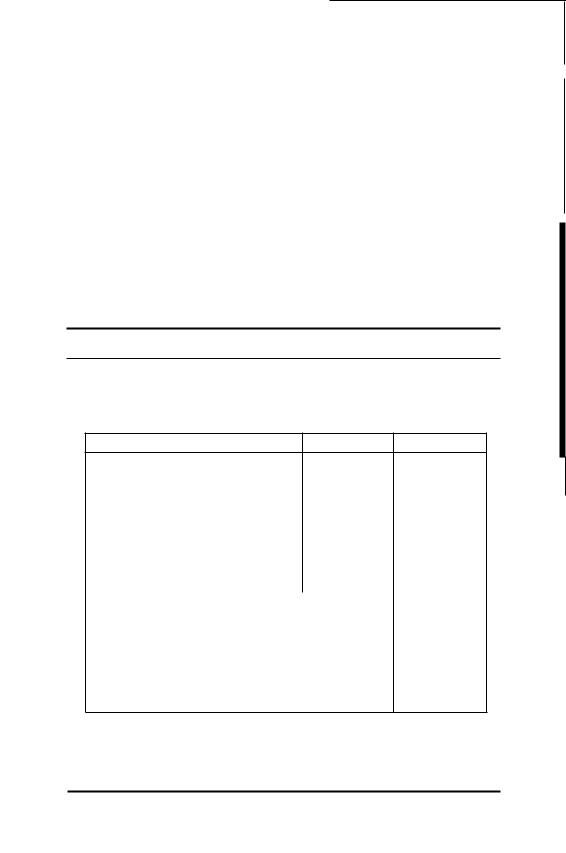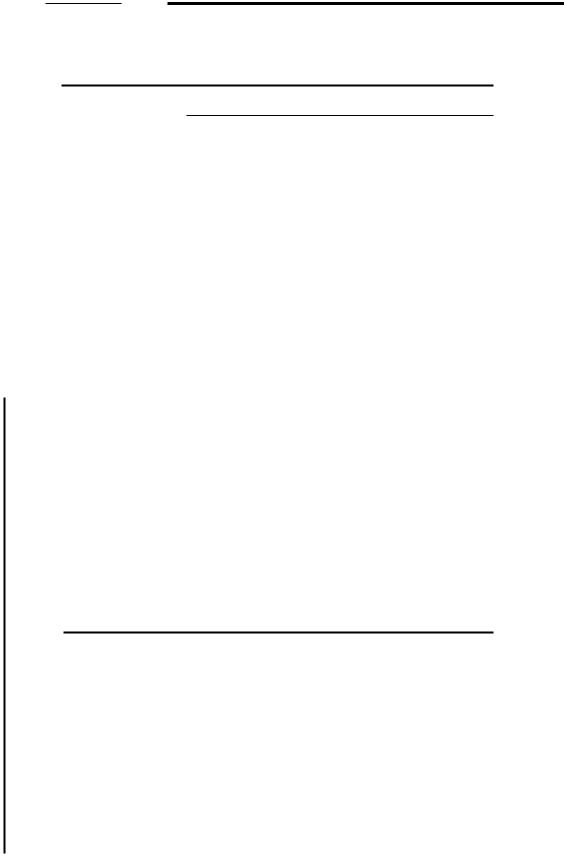
Английский язык / Английский язык для медиков / Swales John M., Feak Christine B. Academic Writing for Graduate Students. Essential Tasks and Skills
.pdf
8: CONSTRUCTING A RESEARCH PAPER II |
339 |
Claiming Centrality
In the "University-Community Agency Collaboration" passage, claiming centrality (Move 1a) was achieved by stressing the growing problem of coping with the elderly in Sentences j, c, and i. In the Eakins text, centrality was created by stressing the artist's growing status and the growing amount ofliterature devoted to his work (Sentences 1-2). In the bridges text, the authors assert centrality by establishing the "serious corrosion-induced deterioration" in many concrete bridges in northern North America (Sentences 1-3).
In Move la certain fixed phrases (or small variants of them) tend to recur. In many cases, the present perfect is used, often with a time expression such as In recent years. We list some with the number of Google Scholar hits we found in May 2012.
TASK SEVEN
Update the numbers in the table, and try and find two more opening expressions with more than 1,000 hits.
Phrase |
Hits Spring 2012 |
Hits Now |
· .. has been extensively studied. |
214,000 |
· .. there has been growing interest in . |
17,800 |
|
|
Recent studies have focused on . " |
17,400 |
|
|
· .. has become a major issue ... |
7,290 |
|
|
·.. remains a serious problem " . |
7,280 |
· .. there has been increasing concern .. |
4,680 |
|
|
·.. has been investigated by many researchers. |
4,270 |
|
|
· .. has become an important aspect of . |
2,470 |
|
|
|
Number of Hits |
|
|
One of your own |
|
|
|
One of your own |
|
Now look at the Introduction openings in your reference collection. How many have a Move 1a? Do they use any of the phrases in the table or similar ones? If not, how do your authors claim centrality?


8: CONSTRUCTING A RESEARCH PAPER II |
341 |
Swales and Leeder (2012) studied the citations to the 154 articles published in the 1990s in the English for Specific Purposes Journal-a journal that incidentally figures prominently in the references in this volume. They found that the two most-cited articles
•were written by women.
•were written by non-native speakers of English.
•were not by authors working in Anglophone countries.
•were not by authors working at famous universities.
In other words, Swales and Leeder found no evidence of bias; rather, the two papers were highly cited because they had something important and something new to say.
If the role of citations is better understood and accepted these days, this is
not true of a subclass of references usually known as self-citations. These are
citations to an author's own previously published or presented work. In an
era when numbers of citations are becoming increasingly important in the evaluation of individuals, self-citations remain controversial. There are two main reasons for this: one is whether they should "count" in evaluations; the
second is whether the motives for self-citing are somehow different from
those of citing others.
,L. illJ |
ill |
, |
TASK NINE
Read these eight summaries of research papers on self-citing. Then
organize a literature review.
1.Snyder and Bonzi (1989)
Patterns of self-citation in six disciplines were examined. 9%
of all citations were self-citations: 15% in the physical sci-
ences, 6% in the social sciences, and 3% in the humanities.
2.Bonzi and Snyder (1991)
A study of 51 authors in the natural sciences revealed only a few differences in motivation between citing oneself and citing others.


8: CONSTRUCTING A RESEARCH PAPER II |
343 |
As you will have noted, these eight studies have been listed in chronolog- ical order. Unless a topic has a clear, linear development over time, a chronological structure is rarely the best way of organizing a literature review, although it may work well enough with some subsets of the material. More generally, the key point about reviews of the literature is that they should clearly show an organizing mind at work. Several ways of organizing may be possible, but what readers, reviewers, and editors want to see is an author who imposes order on the material, rather than producing simple undigested lists of what has been done.
Now here is one student's approach to organizing self-citation material in an Introduction.
o I am going to do this specific-general, starting with basic facts.
oI will start with the self-cite percentages: so I'll start with references 1, 7, and part of 8.
oThen I will cover the explanations for self-citing and will use references 4 and 5.
oThen I will focus on individual variation and draw from reference 3 and mention 8.
oAfter this I will discuss research on self-citation effects using references 2,6, and 8.
oFinally, I should say something about policy implications and the need for further studies.
Is this how you would do it? Can you suggest a better alternative? Discuss
with a partner.

344 |
ACADEMIC WRITING FDR GRADUATE STUDENTS |
Sill Language Focus: Citation and Tense
~
Tense choice in reviewing previous research is subtle and somewhat flexible. (It is also not very much like the "rules" you may have been taught in English classes.) The following, therefore, are only general guidelines for tense usage.
Several studies have shown that at least two-thirds of all citing statements fall into one of these three major patterns.
Pattern 1
Past-researcher activity as agent
Huang (2007) investigated the causes of airport delays.
The causes of airport delays were investigated by Huang
(2007).
Pattern 2
Present Perfect-researcher activity not as agent
The causes of airport delays have been widely investigated (Hyon, 2004; Huang, 2007; Martinez et aI., 2010).
There have been several investigations into the causes of airport delays (Hyon 2004; Huang, 2007; Martinez et aI., 2010).
Several researchers have studied the causes of airport delays.'-3
Pattern 3
Present-no reference to researcher activity
The causes of airport delays are complex (Hyon, 2004; Huang, 2007, Martinez et aI., 2010).
Airport delays appear to have a complex set of causes.'-3
Note the common uses of these patterns.
Pattern I-reference to single studies-past
Pattern 2-reference to areas of inquiry-present perfect
Pattern 3-reference to state of current knowledge-present
Also note that in Patterns 1 and 2, attention is given to what previous
researchers did, while in Pattern 3 the focus is on what has been found.
Finally, note that different areas of scholarship have somewhat different
preferences. Patterns 1 and 2 are most common in the humanities and the

8: CONSTRUCTING A RESEARCH PAPER II |
345 |
social sciences and least common in the areas of science, engineering, and
medical research. However, all three patterns tend to occur in many exten-
sive literature reviews since they add variety to the text.
We have said that these three patterns cover ahout two-thirds of the cases.
The reason this proportion is not higher is because writers of literature
reviews can have certain options in their choice of tenses. This is particularly true of Pattern 1. The main verbs in Pattern 1 can refer to what a previous
researcher did (investigated, studied, analyzed, etc.). By and large, in these
cases the past is obligatory. However, the main verbs can also refer to what
the previous researcher wrote or thought (stated, concluded, claimed, etc.). With this kind of reporting verb (see Unit Five), tense options are possible.
Rogers (2004) concluded that business failure may be related to reduced working capital and retained earnings.
Rogers (2004) has concluded that ....
Rogers (2004) concludes that ....
The differences among these tenses are subtle. In general, moves from past to present perfect and then to present indicate that the research reported is
increasingly close to the writer in some way: close to the writer's own opinion,
close to the writer's own research, or close to the current state of knowledge.
The present tense choice is sometimes called the citational present and is
also used with famous or important sources.
Aristotle argues that ....
Confucius says ... .
The Bible says ... .
The Constitution states ....
Comparable options exist in the subordinate clause.
Rogers (2004) found that business failure was correlated most closely with reduced working capital.
Rogers (2004) found that business failure is correlated most closely with reduced working capital.
The first sentence shows that the writer believes that the finding should be understood within the context of the single study. In the second, the writer implies that a wider generalization is possible. (However, it should be noted that some editors disapprove of the use of present tense here.)

346 |
ACADEMIC WRITING FOR GRADUATE STUDENTS |
TASK TEN
Review the previously highlighted citations in your reference collection. Which tenses are the most frequent? How does your data fit with the three patterns we have identified?
Variation in Reviewing the literature
In the Language Focus on pages 344-345. we concentrated on the three
main citation patterns. There are, of course, some others.
According to Suarez et al. (20] 0), the causes of business failure are closely related to the ratio of working capital, retained earnings, and sales.
Fang's research shows that reduced working capital and retained earnings are interrelated (Fang, 2007).
Can you come up with others?
Good writers of literature reviews employ a range of patterns in order to vary their sentences. Another form of variation involves the use of integral
and non-integral citations. When the cited author is grammatically part of a
sentence, the citation is referred to as integral. When the cited author is given in parentheses or referred to by a number, the citation is non-integral.
Pattern 1 on page 344 contains integral citations. Non-integral citations
appear in Pattern 2.
Most citations are non-integral. Under what circumstances would an
integral citation be preferred?

8: |
CONSTRUCTING A RESEARCH PAPER II |
347 |
w |
w |
|
|
|
TASK ELEVEN
Choose one of these tasks.
1.Write up a review of the self-citation literature.
2.Revise this passage.
The passage uses only the first citation pattern. As you can see, using the same structure all the time can cause the reader to lose interest.
Re-write it to add more variety and provide a more apparent organization structure. Your version will probably be shorter than the orig- inal-another advantage!
The Origins of the First Scientific Articles
Banks (201 1) describes the founding of the first scientific journals
in London and Paris in the 1660s. Obviously, the first scientific arti·
cles had no direct models to build on, and several scholars have discussed Possible infiuences. Ard (1983) and Valle (2000) suggest that the first articles developed from the scholarly letters that sci· entists were acCustomed to sending to each other. Sutherland (1986) showed that early articles were also influenced by the news· paper reports of that time. Paradis (1987) described the influence of the philosophical essay. Shapin (1984) claimed that the scientific books of Robert Boyle were another model. Bazerman (1988, 1997) argued that discussions among the scientists themselves made their own COntribution to the emergence of the scientific article. Finally, Gross (1990, 2008) ascribes their origins to inventories of nature and natural products.
Rlij .4:\0&;..

348 |
ACADEMIC WRITING FOR GRADUATE STUDENTS |
Move 2: Establishing a Niche
In many ways, Move 2 is the key move in Introductions to longer research
papers. (However, this move may not be needed in shorter communica-
tions.) It is the hinge that connects Move 1 (what has been done) to Move 3 (what the present research is about). Move 2 thus establishes the motivation for the study. By the end of Move 2, the reader should have a good idea of what is coming in Move 3.
Most Move 2s establish a niche by indicating a gap-by showing that the
research story so far is not yet complete. Move 25 then function as a mini-
critique (see Unit Six). Usually Move 2s are quite shorr, often consisting of
no more than a sentence Of two. Let us examine the Move 25 in the first
three Introductions we have seen so far.
Thomas Eakins
Apart from a chapter in Foster (1997), this series has been little discussed by critics or art historians. For example, these pictures were ignored by Johns in her ....
Durability Monitoring (bridges)
The widespread deterioration and recent collapses of highway bridges ... have highlighted the importance of developing effective bridge inspection and maintenance strategies.
University-Community Agency Collaboration
Little is, however, known about participants' views of university-
community collaborations.
As you can see, the first and third are straightforward gap indications. The second is rather more subtle. It implies, but does not directly state, that cur-
rent bridge inspection strategies need to be improved.
A fuller range of options for Move 2 is presented in Figure 17.
FIGURE 17. Options for Establishing a Niche
A. counter-claiming (something is wrong) |
Stronger |
B.indicating a gap (something is missing)
C.raising a question or making an inference
(something is unclear) (Kwan and Chan, 2011)
D. continuing a tradition (adding something) |
Weaker |
|
|
